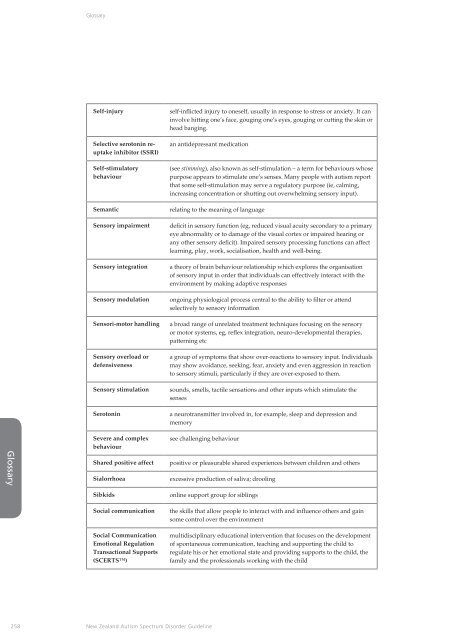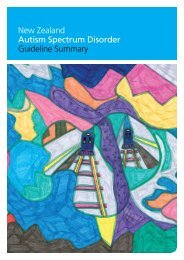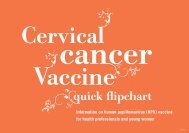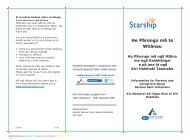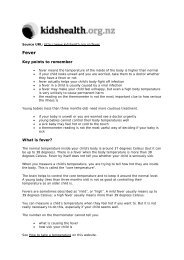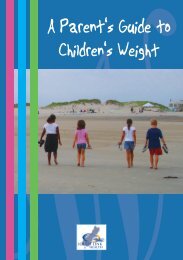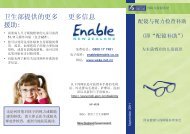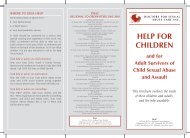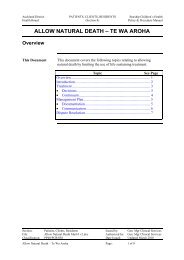New Zealand Autism Spectrum Disorder Guideline - Ministry of Health
New Zealand Autism Spectrum Disorder Guideline - Ministry of Health
New Zealand Autism Spectrum Disorder Guideline - Ministry of Health
Create successful ePaper yourself
Turn your PDF publications into a flip-book with our unique Google optimized e-Paper software.
Glossary<br />
Self-injury<br />
Selective serotonin reuptake<br />
inhibitor (SSRI)<br />
Self-stimulatory<br />
behaviour<br />
Semantic<br />
Sensory impairment<br />
Sensory integration<br />
Sensory modulation<br />
Sensori-motor handling<br />
Sensory overload or<br />
defensiveness<br />
Sensory stimulation<br />
Serotonin<br />
self-inflicted injury to oneself, usually in response to stress or anxiety. It can<br />
involve hitting one’s face, gouging one’s eyes, gouging or cutting the skin or<br />
head banging.<br />
an antidepressant medication<br />
(see stimming), also known as self-stimulation – a term for behaviours whose<br />
purpose appears to stimulate one’s senses. Many people with autism report<br />
that some self-stimulation may serve a regulatory purpose (ie, calming,<br />
increasing concentration or shutting out overwhelming sensory input).<br />
relating to the meaning <strong>of</strong> language<br />
deficit in sensory function (eg, reduced visual acuity secondary to a primary<br />
eye abnormality or to damage <strong>of</strong> the visual cortex or impaired hearing or<br />
any other sensory deficit). Impaired sensory processing functions can affect<br />
learning, play, work, socialisation, health and well-being.<br />
a theory <strong>of</strong> brain behaviour relationship which explores the organisation<br />
<strong>of</strong> sensory input in order that individuals can effectively interact with the<br />
environment by making adaptive responses<br />
ongoing physiological process central to the ability to filter or attend<br />
selectively to sensory information<br />
a broad range <strong>of</strong> unrelated treatment techniques focusing on the sensory<br />
or motor systems, eg, reflex integration, neuro-developmental therapies,<br />
patterning etc<br />
a group <strong>of</strong> symptoms that show over-reactions to sensory input. Individuals<br />
may show avoidance, seeking, fear, anxiety and even aggression in reaction<br />
to sensory stimuli, particularly if they are over-exposed to them.<br />
sounds, smells, tactile sensations and other inputs which stimulate the<br />
senses<br />
a neurotransmitter involved in, for example, sleep and depression and<br />
memory<br />
Glossary<br />
Severe and complex<br />
behaviour<br />
Shared positive affect<br />
Sialorrhoea<br />
see challenging behaviour<br />
positive or pleasurable shared experiences between children and others<br />
excessive production <strong>of</strong> saliva; drooling<br />
Sibkids<br />
Social communication<br />
Social Communication<br />
Emotional Regulation<br />
Transactional Supports<br />
(SCERTS)<br />
online support group for siblings<br />
the skills that allow people to interact with and influence others and gain<br />
some control over the environment<br />
multidisciplinary educational intervention that focuses on the development<br />
<strong>of</strong> spontaneous communication, teaching and supporting the child to<br />
regulate his or her emotional state and providing supports to the child, the<br />
family and the pr<strong>of</strong>essionals working with the child<br />
258<br />
<strong>New</strong> <strong>Zealand</strong> <strong>Autism</strong> <strong>Spectrum</strong> <strong>Disorder</strong> <strong>Guideline</strong>


